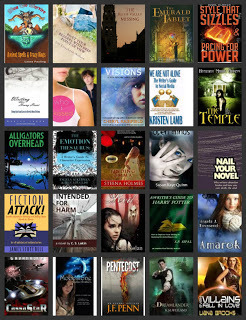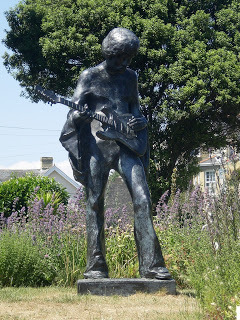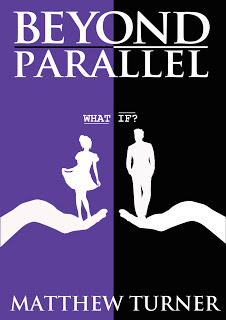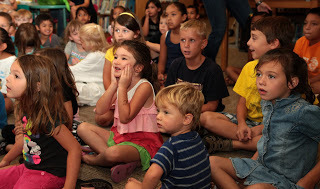Angela Ackerman's Blog: Writers Helping Writers, page 169
January 24, 2013
Celebrate 5 Years With Us & WIN!

Dennisallen
Every time January hits, I am shocked to know that it's been another year of blogging for Becca and me. The same thoughts scroll through my brain: what did I do before this blog? How did I manage to function before realizing I needed to reach out to the blogging community?
I had ties in a few forums of course, and made some wonderful friendships. Heck, Becca and I met at The Critique Circle, an online critiquing community for writers (thank you Universe for making that happen!) But really, for both of us, our world grew bigger and brighter when we met all of you! :)
Crazily enough, we've been at this now for 5 years! FIVE! And in a bizarre twist of fate, we hit two other incredible milestones this month as well:
The Emotion Thesaurus sold over 20,000 copies
&
The blog had its 2,000,000th Hit!
~~ * ~~
CLEARLY a celebration is in order, yes? We think so too, so we're giving away a Kindle Paperwhite loaded with 10 ebooks (winner's choice) from the selection below:

MG & YA Reads:
Janet Gurtler's Who I Kissed
Susan Quinn's Open Minds
Laura Pauling's How To Survive Ancient Spells and Crazy Kings
P.J. Hoover's The Emerald Tablet
Heather Atkins's The Temple
Angela Townsend's Amarok
Kait Nolan's Red
Cheyrl Rainfield's Parallel Visions
C. Lee McKenzie's Alligators Overhead
Marilee Brother's Moonstone
Adult Reads:
C.S. Lakin's Intended For Harm
Amber West's Ruth Valley Missing
K. M. Weiland's Dreamlander
Joanna Penn's Pentecost
Steena Holmes' Finding Emma
Liana Brook's Even Villains Fall In Love
Alex Cavanaugh's CassaStar
Reference:
James Scott Bell's Fiction Attack!
S.P. Sipal's A Writer's Guide To Harry Potter
Kristen Lamb's We Are Not Alone: The Writer's Guide To Social Media
Roz Morris' Nail Your Novel
Jodie Renner's Style That Sizzles & Pacing For Power
Jill Elizabeth Nelson's Rivet Your Readers With Deep POV
Denise Jaden's Writing With A Heavy Heart: Using Grief And Loss To Stretch Your Fiction
Becca & Angela's Emotion Thesaurus: A Writer's Guide To Character Expression
~~ * ~~
SO MANY AMAZING BOOKS, am I right? I am sure the winner will be very happy, no matter which 10 they pick. And hey, that could be YOU, so let's talk about how to get into the draw, shall we?
HOW TO ENTER:
Becca and I are not big on hoop jumping, and this is about CELEBRATING ALL OF YOU, not us. So while of course we would love your TWEETS, LINKS & SHARES, it's not a condition to win. Just simply leave us a comment. Maybe tell us about someone who has helped you recently, and if they have one, leave a link to their blog so that people can visit them.:)
Yep, that simple. :)
Contest closes on January 31st! Good luck everyone, and thank you for all your support!

Published on January 24, 2013 03:00
January 22, 2013
Got Any Wise People in your Village? Or Just Idiots?

Jimi Hendrix statue on the Isle of Wight
I was driving my daughter to school the other day when a Jimi Hendrix song came on. (Someone's got to raise her right, yes?) And I started thinking, as I inherently do when hearing All Along the Watchtower or The Wind Cries Mary or The Best Version of The Star-Spangled Banner EVER, what a shame it was that he died so young. Only 27 at the time of his death—over 40 years ago— and he’s still hailed as one of the most talented guitarists of all time.
It's a sadly familiar story—the brilliant young talent who burns out early due to death, addiction, bad choices, or just giving the idiots undue influence over his life: Vincent Van Gogh, James Dean, Virginia Woolf, Jim Morrison, Michael Vick, John Belushi. Careers and lives crashing to a halt at the height of success due to unfortunate and completely avoidable circumstances. And it always makes me wonder: where were their Wise People?
Writers that we are, we’re not under the same pressure as celebrities and geniuses. Our decisions are simpler, our temptations less life-threatening. But the possibility for premature burn-out among authors is still great. We have our own kinds of pressures—to achieve a nearly impossible dream, to prove our talent to ourselves and others, to consistently churn out work that is lauded, sells well, and outshines our previous efforts. Fear is a constant companion, accompanied by self-doubt, insecurity, and indecision—all hindering and inhibiting us at every turn. And as if the internal demons weren’t enough, we also have to face the expectations and criticism of family members and friends, colleagues, readers, and industry professionals.
It's a miracle we ALL don't end up self-medicating.
The fact is, we need some wise people in our lives if we're going to succeed in the long haul. In this industry, having knowledgeable, honest, and caring advisors is not only recommended, it’s imperative. We need people
who understand and encourage our passion.
who are truthful about the quality of our work and how far we have to go.
who challenge us.
who can help us navigate new territory.
who will tell us when we’re headed down the wrong path.
who have our best interests at heart.
who love us unconditionally.
Rarely can one person fulfill all these duties. Much like the proverbial village needed to raise a child, it takes a council of wise advisors to help any of us succeed as writers.
If your team is lacking any of these key players, find them—in critique groups, on message boards, at conferences. Pilfer them from your writing friends. Latch onto those people who fit the bill and cut the riffraff loose. I know—you can’t exactly jettison your boss, or your spouse, or your Drunk Aunt Alice. But you can recognize the naysayers for who they are: people in your life who love you and have value but aren’t wise when it comes to your writing. They have no business holding a position of influence at that particular council table. Relieve them of those duties and bring in others who can get the job done.
Remember: you are responsible for the people you allow to advise you and influence your writing journey. Make sure those individuals are wise. Then be the wise people for someone else.

Published on January 22, 2013 00:00
January 19, 2013
Physical Attribute Thesaurus: Eyebrows

photo credit: César Augusto Serna Sz via photopin cc
Physical description of a character can be difficult to convey—too much will slow the pace or feel 'list-like', while too little will not allow readers to form a clear mental image. If a reader cannot imagine what your character looks like, they may have trouble connecting with them on a personal level, or caring about their plight.
One way to balance the showing and telling of physical description is to showcase a few details that really help 'tell the story' about who your character is and what they've been through up to this point. Think about what makes them different and interesting. Can a unique feature, clothing choice or way they carry themselves help to hint at their personality? Also, consider how they move their body. Using movement will naturally show a character's physical characteristics, keep the pace flowing and help to convey their emotions.
EYEBROWS
Descriptors : arched, curved, shaped, waxed, patchy, bushy, shaved, colored, bleached, unruly, plucked, waxed, joined, furry, cottony, strips, high, bald, pierced, thick, dark, pale, angled, bent, scarred, tattooed, lined, uni-brow, symmetrical; tinted; over tweezed, dirty, scaly
Things Eyebrows Do
Furrow: gather, pinch, tighten, draw together, join, press, meld; knit
Raise: lift, rise, arch, jump, boost, hike
Lower: crouch, slump, slant, sink, collapse
Key Emotions and Related Eyebrow Gestures:
Surprise: Eyebrow shoot up with shock or may rise gradually at a slower realization or surprise. The brows are difficult to control, and so even if a character is trying to hide their surprise, often their brows will lift slightly before they are able to bring them under control
Fear: brows draw together and curl slightly when the character is afraid, contrasting with a widening of the eyes. A wrinkle appears between the brows
Sympathy: The brows draw down and together ever so slightly
Simile and Metaphor Help:
When Uncle Dean laughed, his eyebrows jiggled like two barking poodles.
Sara's eyebrows stretched out, sleek and graceful, a pair of falcons in flight.
Clichés to Avoid : raising a single eyebrow, overusing an arched eyebrow as a response to a stupid question; eyebrows that furrow constantly
HINT: When describing any part of the body, try to use cues that show the reader more than just a physical description. Make your descriptions do double duty. Example:
Great Aunt Neddie slapped down her gin and tonic, hitched up her pantyhose and lurched across the dance floor to Edward's handsome Uncle Reese. Her uneven gait made her feathery eyebrows weave like two battered rowboats, but her eyes were fixed on the one that got away.
BONUS TIP: The Colors, Textures & Shapes Thesaurus in our sidebar might help you find a fresh take on some of the descriptors listed above!

Published on January 19, 2013 04:00
January 15, 2013
Matthew Turner: Using A Short Story To Rock My Novel
In the new landscape of publishing, it's always interesting to hear what different authors are doing to get their books noticed. Today Matthew Turner of Turndog Millionaire is with us to show how he used a short story to build momentum for his book, Beyond Parallel, a coming-of-age story that flips between two parallel lives.
Standing out can be difficult, and Matt's background in Strategic Marketing means he has some great experience to offer. Enjoy!
~ ~ * ~ ~

Writing is hard! … Editing is excruciating! … Finishing is torture!
However, none of these are the hardest part about writing a book. The hardest part about being a modern day writer is becoming visible in a very invisible world.
When you're a debut novelist (like moi), trying to get noticed is your main priority. When you're a self-published debut novelist (again, like moi), it's imperative you don't become part of Amazon's black hole.
When I was planning the release of Beyond Parallel I started to think about how I could stand out from the crowd. I wanted readers, supporters, and email addresses. I needed people who would read and share and express their feelings, no matter how good or bad they were.
This plan had many facets, but it was a short story that was the most intriguing. Not only was it a way to improve my writing, but it allowed me to reach potentially thousands of readers who hadn't previously read my words.
Would you like to learn how I did it?
A Short Story To Kick Things Off
In October I released Tales From A Tiny Thai Table, a 5,000 word prequel that's set the night before Beyond Parallel begins. It's a short story that introduces the main characters, provides and insight into what to expect, and is jam packed with behind the scenes info about me and the book.
These are the benefits my short story offered:
It got the reader excited about Beyond Parallel
It was further practice for my writing
It allowed me to offer something for FREE (give before you take)
It gave me emails and names for future releases
It was a dummy-run of the publishing process
I learned the ins and outs of Amazon and Smashwords
I was able to practice some launch day ideas
It allowed me to share behind the scenes info
I was able to extend the story of Beyond Parallel
Of course, this was potential only. It could totally backfire, but I felt it was worth the risk. A crazy risk? Maybe, but I did do a few things to help my cause.
Removing The Risk
I wanted to take this process very seriously, just like I would any book/launch. It wasn't perfect, and it didn't tick all of the boxes I had hoped for. However, it was an amazing experience and I'm happy to share my thoughts:
1: Professionally Edited:
My editor, Susan, edited Tales From A Tiny Thai Table. It was important to make sure the quality was high. I wanted to showcase my skills, not an un-edited piece of awful!
I didn't stop here though as I asked three people to Beta Read for me. This allowed me to take it to the next level and produce a piece of work that was worthy of the world.
2: Created A Launch Plan:
As a marketer my Book Plan is rather detailed. I created a mini plan for Tales From A Tiny Thai Table, and overall approached it like I would any other launch day.
I knew things would go wrong (they did) and I knew I'd learn a lot (I did). I wanted to go all out, though. It might have been FREE, but I wanted it to reach as many people as it could. If I simply released and hoped, it would have been a waste of time.
3: Advertising:
I decided not to spend any money on advertising, but I did utilize dozens of Free Directories that showcase Free Ebooks. This took a few hours to find, and a further few to fill in the necessary details.
It was totally worth it, though as I reached hundreds of people I wouldn't have otherwise reached. You'd be amazed at what the internet offers if you do some searching.
4: Persistence Is Important:
Don't SPAM, but at the same time don't let your book become invisible. Keep Tweeting and sharing your Short Story. Make it easy for people to download and approach as many people as you can.
I had a couple of months between Tales From A Tiny Thai Table and Beyond Parallel. Prior to 2013 I wanted people to download the short story and get a taster for what was to come. It also allowed me to talk about Beyond Parallel without feeling like a dirty salesman :)
Was It Worth It?
110% YES!!!!
It didn't bring the results I had hoped for, but the lessons learned were invaluable. You can read about Smashwords and Amazon, but it isn't until you see it first hand that it really makes sense.
I encourage you to read my Post on getting your Book on Amazon on FREE and avoid the mistakes I made.
The results: I received well over 500 downloads, many of whom didn't know me beforehand. Few signed up to my mailing list, so I'm not sure what the long-term benefits will be. It was far from a roaring success, but it did reach as high as No.6 on the Amazon Short Story Charts. That's pretty darn cool :)

Would I do it again? YES!
I love to give before I take, and this was a way to offer my readers a FREE sample before the big day. I'm not sure whether a short story would work for you, but it's certainly worth considering.
What are your thoughts? I'd love you to share them below...
Matthew Turner is a young writer from Yorkshire, England. His debut novel, Beyond Parallel , is a coming-of-age story about two young twenty-somethings. In the mould of Sliding Doors, it’s set on a parallel timeline; one story follows Bella and Clark as a couple, the other as if they never meet.
What I really like about Matthew's usage here of the free story is that he released it prior Beyond Parallel, rather than offering it months afterward as many other authors do. I think this was a really smart way to pull potential readers into the world of BP beforehand, and to showcase his storytelling style! And as a side note, I think the concept of his book is compelling--don't all of us wonder what our lives would be like if we made different choices, and followed different paths?
A big thank you to Matthew for hanging out with us today. If you want to find out more about this book and how he helps writers, check out Turndog Millionaire. And if you want to keep track of Beyond Parallel, you can add it to your Goodreads List right here.
GIVEAWAY ALERT! Matthew is giving a copy of his book, Beyond Parallel to one reader, so leave us a comment with some contact information and you're in the draw!
Standing out can be difficult, and Matt's background in Strategic Marketing means he has some great experience to offer. Enjoy!
~ ~ * ~ ~

Writing is hard! … Editing is excruciating! … Finishing is torture!
However, none of these are the hardest part about writing a book. The hardest part about being a modern day writer is becoming visible in a very invisible world.
When you're a debut novelist (like moi), trying to get noticed is your main priority. When you're a self-published debut novelist (again, like moi), it's imperative you don't become part of Amazon's black hole.
When I was planning the release of Beyond Parallel I started to think about how I could stand out from the crowd. I wanted readers, supporters, and email addresses. I needed people who would read and share and express their feelings, no matter how good or bad they were.
This plan had many facets, but it was a short story that was the most intriguing. Not only was it a way to improve my writing, but it allowed me to reach potentially thousands of readers who hadn't previously read my words.
Would you like to learn how I did it?
A Short Story To Kick Things Off
In October I released Tales From A Tiny Thai Table, a 5,000 word prequel that's set the night before Beyond Parallel begins. It's a short story that introduces the main characters, provides and insight into what to expect, and is jam packed with behind the scenes info about me and the book.
These are the benefits my short story offered:
It got the reader excited about Beyond Parallel
It was further practice for my writing
It allowed me to offer something for FREE (give before you take)
It gave me emails and names for future releases
It was a dummy-run of the publishing process
I learned the ins and outs of Amazon and Smashwords
I was able to practice some launch day ideas
It allowed me to share behind the scenes info
I was able to extend the story of Beyond Parallel
Of course, this was potential only. It could totally backfire, but I felt it was worth the risk. A crazy risk? Maybe, but I did do a few things to help my cause.
Removing The Risk
I wanted to take this process very seriously, just like I would any book/launch. It wasn't perfect, and it didn't tick all of the boxes I had hoped for. However, it was an amazing experience and I'm happy to share my thoughts:
1: Professionally Edited:
My editor, Susan, edited Tales From A Tiny Thai Table. It was important to make sure the quality was high. I wanted to showcase my skills, not an un-edited piece of awful!
I didn't stop here though as I asked three people to Beta Read for me. This allowed me to take it to the next level and produce a piece of work that was worthy of the world.
2: Created A Launch Plan:
As a marketer my Book Plan is rather detailed. I created a mini plan for Tales From A Tiny Thai Table, and overall approached it like I would any other launch day.
I knew things would go wrong (they did) and I knew I'd learn a lot (I did). I wanted to go all out, though. It might have been FREE, but I wanted it to reach as many people as it could. If I simply released and hoped, it would have been a waste of time.
3: Advertising:
I decided not to spend any money on advertising, but I did utilize dozens of Free Directories that showcase Free Ebooks. This took a few hours to find, and a further few to fill in the necessary details.
It was totally worth it, though as I reached hundreds of people I wouldn't have otherwise reached. You'd be amazed at what the internet offers if you do some searching.
4: Persistence Is Important:
Don't SPAM, but at the same time don't let your book become invisible. Keep Tweeting and sharing your Short Story. Make it easy for people to download and approach as many people as you can.
I had a couple of months between Tales From A Tiny Thai Table and Beyond Parallel. Prior to 2013 I wanted people to download the short story and get a taster for what was to come. It also allowed me to talk about Beyond Parallel without feeling like a dirty salesman :)
Was It Worth It?
110% YES!!!!
It didn't bring the results I had hoped for, but the lessons learned were invaluable. You can read about Smashwords and Amazon, but it isn't until you see it first hand that it really makes sense.
I encourage you to read my Post on getting your Book on Amazon on FREE and avoid the mistakes I made.
The results: I received well over 500 downloads, many of whom didn't know me beforehand. Few signed up to my mailing list, so I'm not sure what the long-term benefits will be. It was far from a roaring success, but it did reach as high as No.6 on the Amazon Short Story Charts. That's pretty darn cool :)

Would I do it again? YES!
I love to give before I take, and this was a way to offer my readers a FREE sample before the big day. I'm not sure whether a short story would work for you, but it's certainly worth considering.
What are your thoughts? I'd love you to share them below...
Matthew Turner is a young writer from Yorkshire, England. His debut novel, Beyond Parallel , is a coming-of-age story about two young twenty-somethings. In the mould of Sliding Doors, it’s set on a parallel timeline; one story follows Bella and Clark as a couple, the other as if they never meet.
What I really like about Matthew's usage here of the free story is that he released it prior Beyond Parallel, rather than offering it months afterward as many other authors do. I think this was a really smart way to pull potential readers into the world of BP beforehand, and to showcase his storytelling style! And as a side note, I think the concept of his book is compelling--don't all of us wonder what our lives would be like if we made different choices, and followed different paths?
A big thank you to Matthew for hanging out with us today. If you want to find out more about this book and how he helps writers, check out Turndog Millionaire. And if you want to keep track of Beyond Parallel, you can add it to your Goodreads List right here.
GIVEAWAY ALERT! Matthew is giving a copy of his book, Beyond Parallel to one reader, so leave us a comment with some contact information and you're in the draw!

Published on January 15, 2013 03:30
January 12, 2013
Physical Attributes Entry: Skin

Rhinocerous skin, courtesy of Sanjay ach
Physical description of a character can be difficult to convey—too much will slow the pace or feel 'list-like', while too little will not allow readers to form a clear mental image. If a reader cannot imagine what your character looks like, they may have trouble connecting with them on a personal level, or caring about their plight.
One way to balance the showing and telling of physical description is to showcase a few details that really help 'tell the story' about who your character is and what they've been through up to this point. Think about what makes them different and interesting. Can a unique feature, clothing choice or way they carry themselves help to hint at their personality? Also, consider how they move their body. Using movement will naturally show a character's physical characteristics, keep the pace flowing and help to convey their emotions.
SKIN
Descriptors: olive, caramel, brown, black, tan, pale, white, yellowish, gray, ivory, pink, freckled, splotchy, smooth, flawless, rashy, wrinkled, dry, spotted, pocked, hairy, rosy, scarred, saggy, itchy, tingling, acned, oily, glistening, glowing, sweaty, dirty, translucent, veined, warm, hot, cool, icy, shivery, drawn, tight, sensitive, loose, flushed, discolored, ashy, leathery, sickly, wan, pasty, feverish, clammy, sallow, jaundiced, puckered, frostbitten, rough, bruised, sun-damaged
Things Skin Does (and other words/phrases to describe those actions)
Shiver : shudder, jitter, tremble, quiver, tremor
Tingle : prickle, sting, tickle, prick
Blush : flush, bloom, gild, pinken, stain, tint, tinge
Key Emotions and Related Skin Verbs:
Fear : a tightening sensation, prickling or tingling, the hair rising on the arms and back of the neck, over-sensitivity to stimuli, shuddering/trembling/shivering, numbness in the extremities, a sensation of the skin "crawling"
Embarrassment : blushing/pinking/reddening, a flush crawling over the skin, sudden warmth, feeling overheated
Simile and Metaphor Help:
The back of his neck was thick and dark like a leatherback turtle's.
Her skin was a minefield of moles and cancer spots waiting to do her in.
Clichés to Avoid : alligator skin, peaches-and-cream complexion, skin that's paper thin, a sun-kissed hue, porcelain skin
HINT: When describing any part of the body, try to use cues that show the reader more than just a physical description. Make your descriptions do double duty. Example: Lines meandered over her skin, intersecting with scars and puckering where they criss-crossed. It was a roadmap of her past, marking not only the pain but also the changing points that had made her the woman she was today.
BONUS TIP: The Colors, Textures & Shapes Thesaurus in our sidebar might help you find a fresh take on some of the descriptors listed above!
******
Also, Angela's posting today at Lisa Voisin's blog: Do Your Characters Have Emotional Pull? If you've got a minute, stop by and say hi. Happy Saturday!

Published on January 12, 2013 04:42
January 10, 2013
What Makes a Strong Author's Visit—a Teacher's Perspective
For all of us writing for kids, the Author Visit holds equal amounts of terror and excitement. Being there at ground zero, in the classroom or gym, up close with our audience...it's adrenaline charging! But then the doubt and fear creep in: What if they don't like me? What if the kids start to fidget from boredom? What if the teacher grows stone-faced because what I'm covering isn't what she expected?
Author visits are a great time to encourage the love of reading and to enjoy interaction with our audience, so getting caught up in the mental worries is something we need to avoid. When I found out Jillian Terry was a retired teacher interested on blogging about her classroom experience, I asked her for tips to ensure both the audience and author walk away with a bounce in their step. So please, read on, because this is Author Visit GOLD!
~ ~ * ~ ~
THE AUTHOR VISIT

via Labpluto123
It's not uncommon for professionals from all types of backgrounds to visit classrooms to give students some perspective on their area of expertise. It's a nice opportunity for educators to break from the strictures of a daily curriculum so that students can hear firsthand from those who have benefited from a great education. A research scientist might visit a biology class to lecture students on current breakthroughs in the field, or perhaps an entrepreneur will visit students to explain how they started their business.
Along these lines, I thought it might be useful to reflect on what wisdom an author could impart upon a classroom. I never had an author visit my classroom during my time as an educator, but I think that a visit from a professional writer could have had a profound impact on my students. Let's take a look at some of the ways how an author could make their visit to a classroom benefit students.
Share childhood stories about reading
I'm thinking about the phrase "leading by example" with this point. Perhaps one of the best ways that an author could begin their time with a classroom might be to share what they read as a child. Doing so could form an instant bond with the classroom—perhaps some of the author's favorite books are favorites among kids in the class. Sharing childhood experiences will put the entire classroom at ease and will help to put students and the author on the same level. What's more, hearing an author talk about their reading habits as a child might encourage some students to read more.
Explain and demystify the life of the writer

Via Wikimedia Commons
We all have that imagine of the stereotypical writer in our minds, the one perpetuated by all forms of media and entertainment: someone chained to a desk with a typewriter, empty cups of coffee, and endless balls of papers strewn about. A visiting author could do the classroom a favor by demystifying the idea of the writer by explaining just what they do on a day to day basis. The author could talk about writing schedules, dealing with publishers and agents, or what they do in their spare time. Sharing this type of information helps students learn to humanize a profession that might seem too abstract or lofty for them to attain.
Affirm that everyone has trouble writing occasionally
Writing can be one of the most difficult areas to teach students, especially if they aren’t too keen on reading. Part of the difficulty stems from students feeling like they aren’t "smart enough" to write or the misconception that they lack any thoughts worth sharing. Authors can dispel this insecurity by sharing their own struggles with writing. If an author were to share their stories of writer's block, or explain how they, too, have bad days when they feel like they can't write anything, perhaps it will make students feel more at ease about their own writing anxieties. Again, it's all about humanizing the profession and making it less intimidating than it seems, and writing can take all the humanization it can get.
Inspire students to work towards their dreams
Above all, professionals do these visits to inspire students to do great things in their own lives. The takeaway from nearly every one of these career day-style visits is, "If I can make it, so can you. Stay in school, study hard and anything is possible." An author could add their voice to that chorus by explaining how their passion for reading and writing led them to their vocation and giving hope to kids who share the same interests. Students could hear firsthand from someone who makes a living by writing about what they want to write about; and if that won't inspire some students, then I don't know what will.

via Audrey
Jillian Terry is a former educator turned freelancer who writes about higher education, the college experience, US history, and much more for teachingdegree.org among other sites. Feel free to send any comments her way!
WOW! A BIG thank you to Jillian for so kindly sharing all of this with us. I have been in the classroom a few times, but I plan on applying these lessons to make sure I take every opportunity to make it a hit! Have you spent time in the classroom? What did you find worked well to keep the audience engaged? Please share your experience in the comments!
**A small note: I'm guest posting over at The Write Now! Coach blog. I hope you'll swing on by for my advice on What Makes Characters Stand Out To Readers.

Author visits are a great time to encourage the love of reading and to enjoy interaction with our audience, so getting caught up in the mental worries is something we need to avoid. When I found out Jillian Terry was a retired teacher interested on blogging about her classroom experience, I asked her for tips to ensure both the audience and author walk away with a bounce in their step. So please, read on, because this is Author Visit GOLD!
~ ~ * ~ ~
THE AUTHOR VISIT

via Labpluto123
It's not uncommon for professionals from all types of backgrounds to visit classrooms to give students some perspective on their area of expertise. It's a nice opportunity for educators to break from the strictures of a daily curriculum so that students can hear firsthand from those who have benefited from a great education. A research scientist might visit a biology class to lecture students on current breakthroughs in the field, or perhaps an entrepreneur will visit students to explain how they started their business.
Along these lines, I thought it might be useful to reflect on what wisdom an author could impart upon a classroom. I never had an author visit my classroom during my time as an educator, but I think that a visit from a professional writer could have had a profound impact on my students. Let's take a look at some of the ways how an author could make their visit to a classroom benefit students.
Share childhood stories about reading
I'm thinking about the phrase "leading by example" with this point. Perhaps one of the best ways that an author could begin their time with a classroom might be to share what they read as a child. Doing so could form an instant bond with the classroom—perhaps some of the author's favorite books are favorites among kids in the class. Sharing childhood experiences will put the entire classroom at ease and will help to put students and the author on the same level. What's more, hearing an author talk about their reading habits as a child might encourage some students to read more.
Explain and demystify the life of the writer

Via Wikimedia Commons
We all have that imagine of the stereotypical writer in our minds, the one perpetuated by all forms of media and entertainment: someone chained to a desk with a typewriter, empty cups of coffee, and endless balls of papers strewn about. A visiting author could do the classroom a favor by demystifying the idea of the writer by explaining just what they do on a day to day basis. The author could talk about writing schedules, dealing with publishers and agents, or what they do in their spare time. Sharing this type of information helps students learn to humanize a profession that might seem too abstract or lofty for them to attain.
Affirm that everyone has trouble writing occasionally
Writing can be one of the most difficult areas to teach students, especially if they aren’t too keen on reading. Part of the difficulty stems from students feeling like they aren’t "smart enough" to write or the misconception that they lack any thoughts worth sharing. Authors can dispel this insecurity by sharing their own struggles with writing. If an author were to share their stories of writer's block, or explain how they, too, have bad days when they feel like they can't write anything, perhaps it will make students feel more at ease about their own writing anxieties. Again, it's all about humanizing the profession and making it less intimidating than it seems, and writing can take all the humanization it can get.
Inspire students to work towards their dreams
Above all, professionals do these visits to inspire students to do great things in their own lives. The takeaway from nearly every one of these career day-style visits is, "If I can make it, so can you. Stay in school, study hard and anything is possible." An author could add their voice to that chorus by explaining how their passion for reading and writing led them to their vocation and giving hope to kids who share the same interests. Students could hear firsthand from someone who makes a living by writing about what they want to write about; and if that won't inspire some students, then I don't know what will.

via Audrey
Jillian Terry is a former educator turned freelancer who writes about higher education, the college experience, US history, and much more for teachingdegree.org among other sites. Feel free to send any comments her way!
WOW! A BIG thank you to Jillian for so kindly sharing all of this with us. I have been in the classroom a few times, but I plan on applying these lessons to make sure I take every opportunity to make it a hit! Have you spent time in the classroom? What did you find worked well to keep the audience engaged? Please share your experience in the comments!
**A small note: I'm guest posting over at The Write Now! Coach blog. I hope you'll swing on by for my advice on What Makes Characters Stand Out To Readers.

Published on January 10, 2013 05:00
January 7, 2013
What I Read Last Year

Happy 2013, friends! You know, I'm not really a resolution kind of girl, but at the beginning of the year I do like to make professional goals and get organized. Ange and I have been hammering out a business plan for the non-fiction side of things, and I came up with some (hopefully) doable personal writing goals for the year. Also, I cleaned out my desk, which is good, cuz not only does it make me feel all neat and orderly, but it gives me a thrill when I find lost Snickers bars and random dark chocolate-covered almonds rolling around.
They weren't that old. Don't judge.
So anyway, I was doing some planning, and for half a second I considered making some reading goals, too, since reading is another passion of mine. But I decided...no. With writing as a career, you do need to be constantly assessing progress, and making adjustments, and setting goals in order to get where you want to go. Reading, on the other hand (despite being necessary to becoming a successful writer), is what I do for fun. I don't want to start quantifying it and turning something pleasurable into work. So instead, I decided to look back over what I read in 2012 and see what stood out. Here's what I found:

Wikimedia Commons
Books read : 56
Most-Read Genres : dystopian/post-apocalyptic (16) and fantasy (13)
Books I started but didn't finish for one reason or another: 12. What can I say? I'm a book snob.
And to give you a sampling of what I read, here's a breakdown of my most memorable books of 2012:
Most Unique Voice : Above (Bobet)
This voice was Un.Be.Lievable. It was so intricate that I actually kind of struggled through the first page, which could easily have been a turn-off, but it clicked in pretty fast—almost like a second language. The uniqueness and consistency were totally impressive.
Best 2nd Book in a Series : Insurgent (Roth)
Second books tend to sag and go nowhere. This one is easily the best second book of any series that I've read.
The Book I was Most Eager to Recommend : Wonder (Palacio)
I don't want to give too much away, but this book was just filled with hope. Normally, I like dark. I like realistic endings where everything isn't tied up neatly and not everyone gets their way. But the message of this book is something that every child and teenager needs to hear. And to be honest, it was refreshing to read a book that was clean and optimistic enough for all my friends and family to enjoy.
Most Controversial: Drowning Instinct (Bick)
The story was amazing, the writing pristine, the characters empathetic. I finished this book, then couldn't stop thinking about it for days. But the message was one that I just couldn't embrace. With all the dark and gritty YA out there, most people will probably be like, This? She has trouble with THIS? But I'm kind of a prude. And as a former educator, I struggled with the message.
Best Craft Book : Writing Screenplays that Sell (Hauge)
I'm pretty good at the technical part of writing but my storytelling needs work, so I'm focusing on that right now. You'll probably hear me quoting this book, alongside Save The Cat, quite a bit in the new year. Lots of great applications here.
Most Unlikable Hero who Didn't Drive Me Nuts : The Wicked and the Just (Coats)
Maybe the most self-involved, petulant, vindictive, and overall flawed hero I've ever read. But the story was so compelling that I never once considered putting it down. And by the end, I found myself empathizing with the main character. This book is a great example of how to write an unsympathetic hero in a way that doesn't turn readers off.
Most Unexpected Twist : Tighter (Adele)
I thought I had this one figured out but I was way off. One of my pet peeves is predictability in books, so this was a nice change.
Most Anticipated Sequel :
1) The third book of The Daughter of Smoke and Bone trilogy
I finished the second book in December, and never have I been more pissed off that I had to wait for the next book to come out. Seriously. Cannot wait.
2) The third book in the Divergent trilogy
I love this series. I'll cry when it's done. And I refuse to believe the propaganda I've read about the author possibly killing off Four. If this happens, I may have to go all Dauntless on Veronica Roth.
Biggest Tearjerker : The Fault in our Stars (Green)
John Green. Enough said.
So what about you? What were your most memorable reads of 2012?

Published on January 07, 2013 00:30
January 5, 2013
Physical Attribute Entry: Fingernails

Marcello Casal Jr/ABr @ WIKIMEDIA
Physical description of a character can be difficult to convey—too much will slow the pace or feel 'list-like', while too little will not allow readers to form a clear mental image. If a reader cannot imagine what your character looks like, they may have trouble connecting with them on a personal level, or caring about their plight.
One way to balance the showing and telling of physical description is to showcase a few details that really help 'tell the story' about who your character is and what they've been through up to this point. Think about what makes them different and interesting. Can a unique feature, clothing choice or way they carry themselves help to hint at their personality? Also, consider how they move their body. Using movement will naturally show a character's physical characteristics, keep the pace flowing and help to convey their emotions.
FINGERNAILS
Descriptors: long, short, ragged, chipped, uneven, bitten, painted, decorated, glossy, pointed, curved, waxy, thick, peeling, missing, cracked, acrylic, false, manicured, yellowed, rounded, curled, flat, blackened, stubby, thin, misshapen, claws, brittle, diseased, colorful, shiny, healthy, shaped, pierced, dirty, polished, buffed, translucent; groomed; hangnail, trimmed, split
Things Nails Do (and other words/phrases to describe those actions)
Pluck: pick, pull, drag, collect, draw, harvest
Lift: pry, wedge, lever, manipulate, force, tamper, raise, heave, jimmy
Scratch: scrape, scuff, cut, scar, chafe, rub, graze
Protect: defend, cover, guard, ward off, cut, slice, repel
Key Emotions and Related Fingernail Gestures:
Nervous: bite, pick at, chew, nibble, strip
Anger: attack, cut, slash, slice, pierce
Pride: admire, paint, polish, shape, manicure, flaunt, adorn, show off
Simile and Metaphor Help:
Clawed: The necromancer's thick nails clicked against the tabletop, a set of yellowed dragon claws ready to strike.
Bitten: Randy's mangled fingernails looked like a dog's well-loved chew toy.
Clichés to Avoid :
overusing nail biting to show nerves
HINT: When describing any part of the body, try to use cues that show the reader more than just a physical description. Make your descriptions do double duty. Example:
Aunt Mary was the eccentric of the family, refusing to cut her nails until they literally began to curl into corkscrews that you could comb your hair with.
BONUS TIP: The Colors, Textures & Shapes Thesaurus in our sidebar might help you find a fresh take on some of the descriptors listed above!

Published on January 05, 2013 03:30
January 1, 2013
Happy New Year!

Wishing all our wonderful writer friends
all the very best in the coming year!
gif via Creative Commons

Published on January 01, 2013 10:30
December 21, 2012
Birthday Shenanigans
Dude.
Did y’all know there were roughly a gajillion awesome people born on December 21st?
Samuel L. Jackson
Ray Romano
Kiefer Sutherland
Jane Fonda
Chris Evert
Phil Donahue
Angela Ackerman

Oh, yes. Today is ANGELA’S BIRTHDAY!! Not only was she born on this day along with all these celebs, she’s way younger than all these people. Now, a moment of full disclosure. I’ve never gone so far as to thank God for Kiefer Sutherland’s birth. Neither have I found myself being grateful that Ray Romano was around to help come up with marketing ideas (though I bet he’d have some good ones). And as far as I can recall, I’ve never been talked down off the self-publishing ledge by Phil Donahue (who probably would have ended up making me jump). But I’ve thanked God for Angela many a time, and I’m so happy to celebrate her special day with all of you!
So please take a minute here, or at Facebook or Twitter, and wish Angela the best birthday ever!

I’m also going to take this opportunity to let everyone know that Angela are starting our blog-cation tomorrow. Please enjoy the next few weeks and all the holiday awesomeness with your families. We wish you the happiest of holidays and we’ll see you again in the new year!
Did y’all know there were roughly a gajillion awesome people born on December 21st?
Samuel L. Jackson
Ray Romano
Kiefer Sutherland
Jane Fonda
Chris Evert
Phil Donahue
Angela Ackerman

Oh, yes. Today is ANGELA’S BIRTHDAY!! Not only was she born on this day along with all these celebs, she’s way younger than all these people. Now, a moment of full disclosure. I’ve never gone so far as to thank God for Kiefer Sutherland’s birth. Neither have I found myself being grateful that Ray Romano was around to help come up with marketing ideas (though I bet he’d have some good ones). And as far as I can recall, I’ve never been talked down off the self-publishing ledge by Phil Donahue (who probably would have ended up making me jump). But I’ve thanked God for Angela many a time, and I’m so happy to celebrate her special day with all of you!
So please take a minute here, or at Facebook or Twitter, and wish Angela the best birthday ever!

I’m also going to take this opportunity to let everyone know that Angela are starting our blog-cation tomorrow. Please enjoy the next few weeks and all the holiday awesomeness with your families. We wish you the happiest of holidays and we’ll see you again in the new year!

Published on December 21, 2012 09:19
Writers Helping Writers
A place for writers to find support, helpful articles on writing craft, and an array of unique (and free!) writing tools you can't find elsewhere. We are known far and wide for our "Descriptive Thesau
A place for writers to find support, helpful articles on writing craft, and an array of unique (and free!) writing tools you can't find elsewhere. We are known far and wide for our "Descriptive Thesaurus Collections" which help authors create vivid imagery and sensory detail for their Settings, Characters (physical descriptions, emotions, skills & talents, etc.), Symbolism, Weather, and a whole bunch more. Stop in and say hello! :) http://writershelpingwriters.net/
...more
- Angela Ackerman's profile
- 1023 followers



